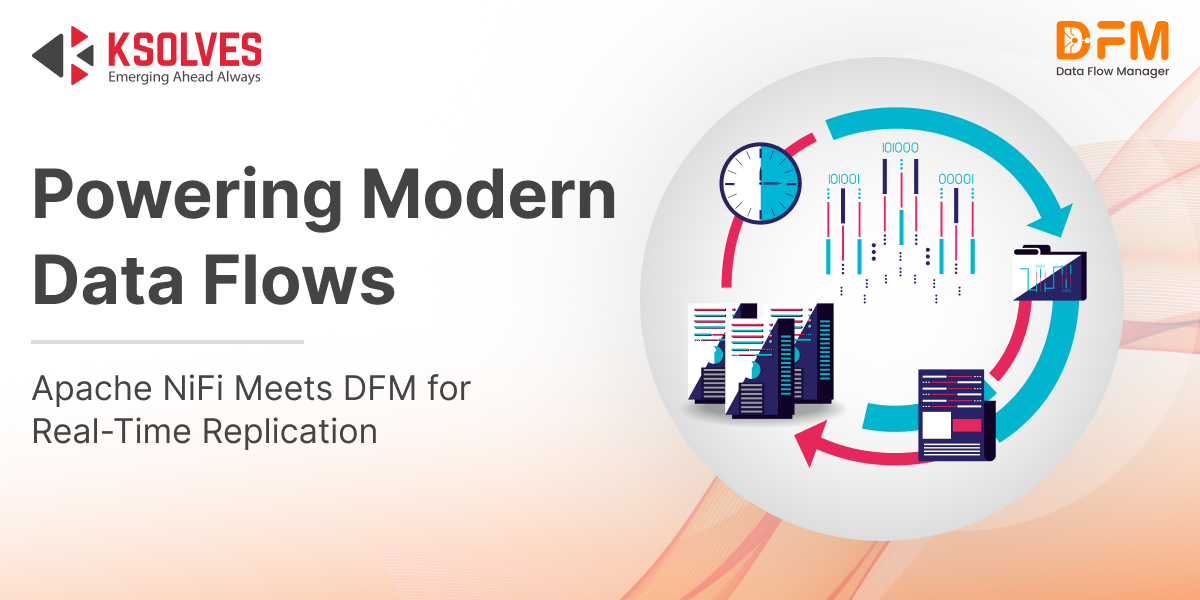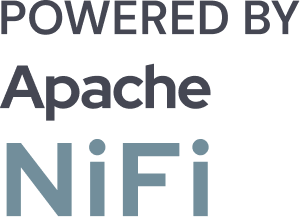Real-Time Data Replication Using Apache NiFi: Powering Seamless Data Movement with DFM
![]()

Businesses generate massive volumes of data every second. Whether it’s transaction logs, sensor streams, application telemetry, or customer behavior data, real-time replication of this information across environments is crucial for insights, agility, and operational efficiency.
Apache NiFi, a powerful open-source data integration tool, has emerged as a cornerstone for organizations looking to achieve real-time data replication with reliability, scalability, and zero-coding overhead. However, while NiFi simplifies data flow design, managing those flows across development, staging, and production environments remains a challenge. That’s where Data Flow Manager (DFM) steps in to complete the picture.
In this blog, we’ll explore how Apache NiFi facilitates real-time data replication and how DFM enhances its manageability across enterprise-grade deployments.
What is Apache NiFi?
Apache NiFi is a robust data ingestion and integration platform designed to automate the movement of data between systems. It supports data ingestion, transformation, routing, and delivery—all through an intuitive, web-based interface that enables developers and data engineers to visually design data flows without writing code.
NiFi’s core strengths lie in:
- Visual Flow Design: Drag-and-drop processors make data flow creation effortless.
- Data Provenance: Track every byte of data with full lineage.
- Scalability: Horizontal scalability for high-throughput systems.
- Back Pressure and Prioritization: Fine-grained flow control.
- Security: TLS encryption, access controls, and policy-based permissions.
Why Real-Time Data Replication Matters
It refers to the continuous synchronization of data from one system to another with minimal latency, ensuring that information is always up to date wherever it’s needed.
Organizations across industries rely on real-time replication to:
- Keep analytics dashboards fresh with live updates from operational systems.
- Power fraud detection and alert mechanisms that rely on instant data to flag anomalies.
- Synchronize transactional databases with data warehouses for timely business intelligence.
- Enable seamless cross-platform reporting across cloud and on-premise systems.
Unlike traditional batch processing, which introduces time lags and operational delays, real-time replication offers key advantages:
- Reduced decision-making latency: Leaders and systems get access to the latest data as it happens.
- Improved data accuracy and freshness, enhancing customer experiences and operational responsiveness.
- Support for reactive systems that require immediate action based on live events.
Whether it’s a retail brand tracking customer behavior in real time or a bank preventing fraudulent transactions within milliseconds, real-time data replication is the engine behind modern digital experiences.
How Apache NiFi Powers Real-Time Data Replication
At the heart of Apache NiFi lies a flow-based programming model, which allows data engineers to visually design, monitor, and control data flows without writing complex code. This makes it ideal for creating custom, real-time replication flows tailored to any business requirement.
Here’s a breakdown of how NiFi facilitates real-time replication from source to destination:
1. Ingestion: Capturing Data in Motion
NiFi offers a rich set of processors like GetFile, GetJDBCRecord, GetKafka, and ListenHTTP, which allow it to ingest data in real-time from virtually any source. Whether you’re pulling structured data from a SQL database, consuming streams from Apache Kafka, or receiving HTTP webhooks from third-party applications, NiFi provides seamless connectivity.
This stage ensures your replication pipeline starts the moment new data is generated—no delays, no manual triggers.
2. Transformation: Shaping the Data
Once data is ingested, it often needs to be cleaned, enriched, or transformed before replication. NiFi supports powerful processors such as UpdateRecord, JoltTransformJSON, and ExecuteScript to perform these tasks.
You can:
- Reformat data into required structures (JSON, Avro, CSV)
- Standardize timestamps, IDs, or units
- Add contextual metadata (e.g., source system tags)
This step ensures the replicated data is ready for downstream analytics or operations.
3. Routing and Delivery: Getting Data to Its Destination
After transformation, NiFi makes it easy to route and deliver data to one or more target systems simultaneously. Using processors like PutDatabaseRecord, PutS3Object, PutKafkaRecord, or InvokeHTTP, data can be delivered to:
- Databases and data warehouses
- Cloud storage like Amazon S3
- Messaging systems like Kafka
- RESTful APIs and webhooks
Whether you’re building a lakehouse architecture, replicating it to a cloud service, or feeding it a real-time dashboard, NiFi handles delivery with precision.
4. Flow Control: Ensuring Reliability and Resilience
What truly sets NiFi apart is its robust flow management capabilities. With features like backpressure, load balancing, retries, and error queues, NiFi ensures that data replication continues smoothly, even if downstream systems slow down or temporarily fail.
This built-in resilience makes NiFi production-grade and fault-tolerant, eliminating the risk of data loss or pipeline failure.
How Data Flow Manager (DFM) Supercharges Real-Time Data Replication in NiFi
While Apache NiFi is a powerful tool for designing data flows for real-time data replication, managing those data flows across multiple environments, like Development, Staging, and Production, can be complex and error-prone. That’s where Data Flow Manager (DFM) steps in.
Data Flow Manager is a purpose-built solution designed to automate, streamline, and secure the deployment and promotion of NiFi data flows across environments in minutes. This ensures consistency, agility, and control at every stage of the replication lifecycle.
Here’s how DFM enhances real-time data replication with NiFi:
1. Effortless NiFi Data Flow Deployment and Promotion
Managing NiFi data flows across different environments typically involves manual export-import processes, CLI tools, or Ansible scripting. Data Flow Manager replaces all that with a simple approach that allows you to deploy and promote NiFi data flows from one environment to another in just a few minutes.
This means:
- Faster rollout of replication data flows from staging to production environments.
- Consistent NiFi data flows deployments with fewer human errors.
- A smooth user experience, even for non-technical stakeholders.
DFM makes NiFi data flow management as simple and agile as building the flows themselves.
2. Version Control and Rollback
Real-time replication data flows often evolve over time as business requirements shift. DFM enables version-controlled deployment of NiFi data flows, allowing teams to track every change made to data flows.
Key benefits include:
- Easy rollback to a previous stable version of NiFi data flows in case of issues.
- Complete visibility into the history of a data flow’s changes.
- Confidence in deploying updates without risking live environments.
This adds a critical layer of operational safety to your replication infrastructure.
3. Audit Trail for NiFi Data Flow Deployment
In data-driven organizations, governance and compliance are non-negotiable. DFM provides a comprehensive audit trail for every NiFi data flow deployment, capturing who deployed what, when, and where.
This feature is especially valuable for:
- Meeting regulatory requirements (GDPR, HIPAA, etc.).
- Enforcing internal data handling policies.
- Conducting post-incident reviews or security audits.
With DFM, your data replication processes are always transparent and traceable.
4. Role-Based Access Control (RBAC)
When multiple teams are involved in designing and managing NiFi flows, it’s important to ensure that each user has the right level of access. DFM supports granular role-based access control, letting administrators define who can:
- View, deploy, or modify specific data flows.
- Promote changes between environments.
- Access sensitive flow configurations or credentials.
RBAC empowers organizations to enforce data security and operational discipline without slowing down innovation.
With DFM, you don’t just manage NiFi data flows; you govern them. Whether you’re replicating data in real-time across cloud platforms, synchronizing systems for analytics, or fueling machine learning pipelines, DFM ensures that every flow is:
- Easy to deploy
- Fully versioned
- Auditable
- Secure
Conclusion
In an era where decisions are made in milliseconds, real-time data replication has become a strategic necessity. Apache NiFi, with its intuitive flow-based architecture, offers a powerful platform to build, manage, and scale real-time data pipelines across diverse systems and formats. From ingestion to transformation and delivery, NiFi handles it all efficiently and reliably.
But to truly operationalize NiFi in enterprise environments, tools like Data Flow Manager (DFM) are essential. DFM enhances NiFi with streamlined data flow deployments, version control, audit trails, and access governance. This ensures your real-time replication pipelines are not just fast, but also secure and compliant. Together, they deliver a robust foundation for modern, data-driven operations.
![]()

